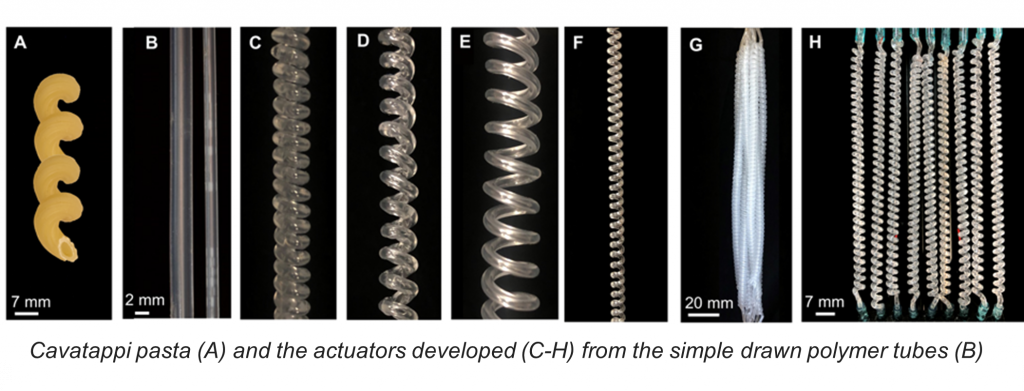(NAU mechanical engineers develop new high- performance artificial muscle technology)
2021/4/21 アメリカ合衆国・ノーザン・アリゾナ大学(NAU)

・ NAU が、新しい高性能人工筋肉技術を開発。
・ ねじれたマカロニのような形状からカヴァタッピ人工筋肉と称する同リニア・アクチュエーター技術は、柔軟性と適応性に優れ、人間の動きにより近く、その骨格筋の能力を超えたロボディクスの動作を可能にする。
・ ねじれたポリマー製アクチュエーター(TPA)をベースとしたらせん構造でより大きな力を提供するため、バイオエンジニアリングやロボティクスのアプリケーションに最適となる。
・ パワフル、軽量で安価な TPA は、開発当時はその革新性が注目されたが、加熱や冷却によるアクチュエーションで動作が遅く、効率性は僅か 2%であった。カヴァタッピ人工筋肉では、加圧液体によるアクチュエーションの採用でこの課題を解決。ソフトアクチュエーション分野では極めて高い、最大約45%のエネルギー効率で収縮する。
・ シンプル、低コスト、軽量、フレキシブルで優れたエネルギー効率性と歪みエネルギー回復性を備えた同人工筋肉は、ソフトロボティクスのアプリケーションをはじめ、歩行ロボット等の従来のロボティックアプリケーションに加え、ロボットスーツや人工義肢等の支援技術での利用が考えられる。
・ 同アクチュエーター技術は知的財産権保護手続きを経て実用化段階にあり、NAU Innovations を通じたライセンシングと提携の準備が完了している。
URL: https://news.nau.edu/artificial-muscle-technology#.YIIpcudUuUk
<NEDO海外技術情報より>
(関連情報)
Science Robotics 掲載論文(アブストラクトのみ:全文は有料)
Cavatappi artificial muscles from drawing, twisting, and coiling polymer tubes
URL: https://robotics.sciencemag.org/content/6/53/eabd5383
Abstract
Compliant, biomimetic actuation technologies that are both efficient and powerful are necessary for robotic systems that may one day interact, augment, and potentially integrate with humans. To this end, we introduce a fluid-driven muscle-like actuator fabricated from inexpensive polymer tubes. The actuation results from a specific processing of the tubes. First, the tubes are drawn, which enhances the anisotropy in their microstructure. Then, the tubes are twisted, and these twisted tubes can be used as a torsional actuator. Last, the twisted tubes are helically coiled into linear actuators. We call these linear actuators cavatappi artificial muscles based on their resemblance to the Italian pasta. After drawing and twisting, hydraulic or pneumatic pressure applied inside the tube results in localized untwisting of the helical microstructure. This untwisting manifests as a contraction of the helical pitch for the coiled configuration. Given the hydraulic or pneumatic activation source, these devices have the potential to substantially outperform similar thermally activated actuation technologies regarding actuation bandwidth, efficiency, modeling and controllability, and practical implementation. In this work, we show that cavatappi contracts more than 50% of its initial length and exhibits mechanical contractile efficiencies near 45%. We also demonstrate that cavatappi artificial muscles can exhibit a maximum specific work and power of 0.38 kilojoules per kilogram and 1.42 kilowatts per kilogram, respectively. Continued development of this technology will likely lead to even higher performance in the future.


